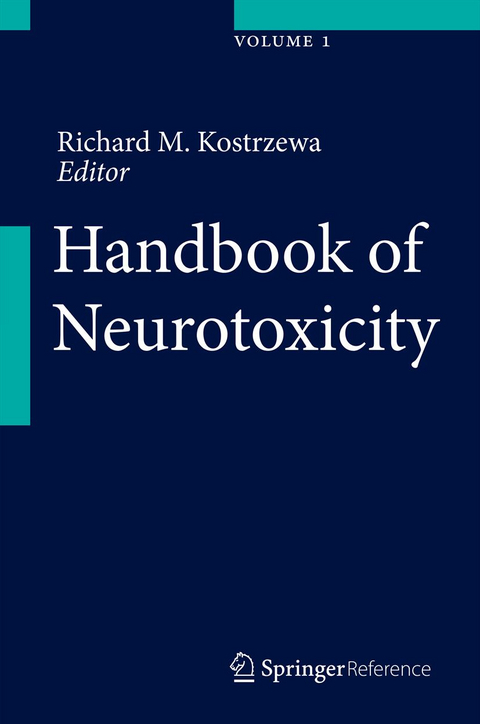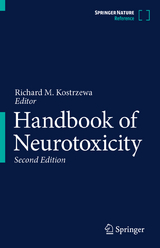
Handbook of Neurotoxicity
Springer-Verlag New York Inc.
978-1-4614-5835-7 (ISBN)
- Lieferbar
- Versandkostenfrei
- Auch auf Rechnung
- Artikel merken
Dr. Kostrzewa is professor of Pharmacology. He received his BS (1967) in Chemistry and MS (1967) in Pharmacology from Philadelphia College of Pharmacy and Science. He received his Ph.D. (1971) in Pharmacology from the University of Pennsylvania and was awarded Doctor Honoris Causa, 2005 from the Medical University of Silesia in Katowice Poland. Following his post-doctoral training in New Orleans he was appointed to the faculty at Louisiana State University. He joined the faculty in the department of Pharmacology at ETSU in 1978, rising to the rank of Professor in 1984. Dr. Kostrzewa is a world recognized authority in the neuropharmacological aspects of Parkinson Disease and ADHD, with a primary focus on Serotoninergic, histaminergic and dopaminergic systems.
Glutamate as a Neurotoxin,- Methamphetamine and MDMA neurotoxicity: Biochemical and molecular mechanisms.- Microglia: Neuroprotective and Neurodestructive Properties.- Neuroprotection in Demyelinating Diseases: the therapeutic potential of the neurotrophins.- Neurotrophic Factors and Ethanol Neurotoxicity.- Neurotrophic factors and NeuroAIDS: a lesson from brain-derived neurotrophic factor.- Neurotrophins and p75NTR in axonal regeneration and myelination.- Neurotrophins and pain.- Neurotrophin signalling in Cancer.- NGF and immune regulation.- NGF/P75 in cell cycle and tetraploidy.- P75 in neuronal death.- p75NTR processing and signaling: functional role.- p75NTR-A molecule with multiple functions in amyloid-beta metabolism and neurotoxicity.- RCSN Cell System for Identifying Dopaminergic Neurotoxicity.- Seizures tip the balance of neurotrophin signaling towards neuronal death.- Survey of Selective Neurotoxins.- Synthesis, trafficking and release of bdnf.- The Nature of DSP-4-Induced Neurotoxicity.- Trafficking of neurotrophins and their receptors and pathological significance.- TRPV1 activators ("vanilloids") as neurotoxins.- Experimental Approach to Alzheimer Disease.- Iron-induced dopaminergic cell death in vivo as a model of Parkinson´s disease.- Molecular, cellular and behavioural effects produced by perinatal asphyxia: protection by poly (ADP-ribose) polymerase 1 (PARP-1) inhibition.- MPTP: advances from an evergreen neurotoxin.- Multifunctional compounds for Parkinsons disease and Alzheimers disease.- Nanomedicines for Nervous System Diseases.- Neurodegenerative aspects of multiple system atrophy.- Neurotoxic profiles of designer-drugs.- Pathophysiology of obsessive-compulsive disorder: Insights from normal function and neurotoxic effects of drugs, infection and brain injury.- Physical Exercise as Intervention in Parkinsonism.- Protective agents in Parkinson´s disease: caffeine and adenosine A2A receptor antagonists.- Stem Cell Therapies for Age AssociatedNeurodegeneration.- AIDS.- Excitotoxicity and axon degeneration.- Glutamate Neurotoxicity related to Energy Failure.- Neuroprotection by Kynurenine Metabolites.- Pain.- Quinolinate and related excitotoxins: mechanisms of neurotoxicity and disease relevance.- Role of Ionotropic Glutamate Receptors in Neurodegenerative and Other Disorders.- Tardive Dyskinesia: Outcome of antipsychotic treatment and brain damage?.- The Concept of Excitotoxicity via Glu-R.- The pathogenesis of Alzheimers disease.- 5,6- and 5,7-Dihydroxytryptamines as Serotoninergic Neurotoxins.- Neurotoxicity of Methamphetamine.- Neurotoxic Effects, Mechanisms and Outcome of 192-IgG Saporin.- Neurotrophic therapy for ALS/ MND.- Cancer-mediated neurotoxicity.- Neurotoxicity in psychostimulant and opiate addiction.- Excitotoxicity in HIV associated neurocognitive disorders.- Necroptosis, a potential therapeutic target for neurological disorders.- Epilepsy.- Excitotoxicity and Amyotrophic Lateral Sclerosis.- Excitotoxicity in the Pathogenesis of Autism.- Glutamate Neurotoxicity, Transport and Alternate Splicing of Transporters.- Glutamatergic receptors in Parkinson`s disease.- Ionotropic Receptors in the Central Nervous System and Neurodegenerative Disease.- Lead & excitotoxicity.- Molecular Mechanism and Effects of Clostridial Neurotoxins.- MS & excitotoxicity.- Neuroprotectants Targeting NMDA Receptor Signaling.- Neurotoxicity and ALS: Insights into Pathogenesis.- Schizophrenia.- Neurotoxic Vulnerability Underlying Schizophrenia Spectrum Disorders.- Glutamate in the Pathogenesis of Gliomas.- Neurotoxicity and Neuroprotection in Spinal Cord Injury.- Drug Abuse Neurotoxicity: Alcohol and Nicotine as Developmental Stressors.- Botulinum neurotoxins as therapeutics.- MPTP Neurotoxicity: Actions, Mechanisms and Animal Modeling of Parkinsons disease.- Endogenous Kynurenic acid and Neurotoxicity.- The potential therapeutic effects of statins in Alzheimer's disease.- Drug Treatments for Alzheimer´s Disease: Hopes and Challenges.- Glutamate and Neurodegeneration in the Retina.- Stroke.- Brain trauma Neuroprotection.- Neuroprotective Strategies in Amyotrophic Lateral Sclerosis: Modulation of Neurotransmittory and Neurotrophic Input to Motor Neurons.- The role of Neurotoxicity in Depression.- Advances in stem cell research for Parkinson disease.- Neurotoxicity in Huntington Disease.- Fusion Models and ´Fusioning`in Parkinsonism: Protection and Restoration by Exercise.- Neurotoxicity: a complex multistage process involving different mechanisms.
| Erscheint lt. Verlag | 4.6.2014 |
|---|---|
| Reihe/Serie | Handbook of Neurotoxicity | 1.10 |
| Zusatzinfo | 147 Illustrations, color; 97 Illustrations, black and white; XXXVIII, 2371 p. 244 illus., 147 illus. in color. In 3 volumes, not available separately. |
| Verlagsort | New York, NY |
| Sprache | englisch |
| Maße | 155 x 235 mm |
| Themenwelt | Studium ► 2. Studienabschnitt (Klinik) ► Pharmakologie / Toxikologie |
| Naturwissenschaften ► Biologie ► Humanbiologie | |
| Naturwissenschaften ► Biologie ► Zoologie | |
| ISBN-10 | 1-4614-5835-8 / 1461458358 |
| ISBN-13 | 978-1-4614-5835-7 / 9781461458357 |
| Zustand | Neuware |
| Informationen gemäß Produktsicherheitsverordnung (GPSR) | |
| Haben Sie eine Frage zum Produkt? |
aus dem Bereich



